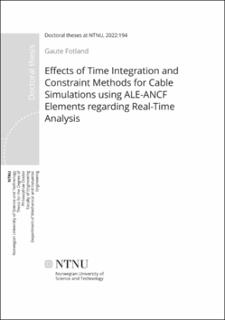| dc.contributor.advisor | Haugen, Bjørn | |
| dc.contributor.advisor | Egeland, Olav | |
| dc.contributor.author | Fotland, Gaute | |
| dc.date.accessioned | 2022-06-09T11:07:26Z | |
| dc.date.available | 2022-06-09T11:07:26Z | |
| dc.date.issued | 2022 | |
| dc.identifier.isbn | 978-82-326-6878-6 | |
| dc.identifier.issn | 2703-8084 | |
| dc.identifier.uri | https://hdl.handle.net/11250/2998113 | |
| dc.description.abstract | The doctoral thesis by Gaute Fotland presents some of the requirements for developing a digital twin of an offshore crane. A digital twin will improve the control system for the crane with a real-time simulation. Furthermore, maintenance prediction could be improved, which again would reduce downtime. Through a systems engineering approach, it was found that a sufficient cable and pulley simulation formulation was vital for a digital twin. The Arbitrary Lagrangian-Eulerian (ALE) -Absolute Nodal Coordinate Formulation (ANCF) cable element was found to be a viable option. The ALE-ANCF cable element has the ability to exhibit large deformations, whilst allowing material to flow through the nodes without the nodes changing position.
The ALE-ANCF cable element was further assessed with two primary targets. Firstly, to investigate how the two common numerical time integrators the 4th order Runge Kutta (RK4) and the Generalized-α (G-α) affects the element. To ensure stability for the RK4 procedure, a criterion to decide for the maximum time-step was developed, based on an effective element length and boundary conditions. In general, the G-α provides fast and accurate results as the high frequencies are dampened out and it is not hampered by requirements of the time-step size. The time-step size can be selected just by ensuring a sufficient number of time steps to capture the desired physical behavior of the model. Secondly, to investigate how the constraint methods used to create longer cable spans connecting cable elements affects the model. Through cases used for benchmarking, the Lagrange multipliers method, the penalty method, and linear coupling are all found to be viable constraint methods.
Finally, the thesis includes an analysis of the RK4 and G-α for a lumped multi-element drill string model, formulated with Kane's method. The motivation was to develop a generic model for three dimensional directional wells, which can function as a virtual sensor for the drilling operation, capable of running real-time simulations. Similar behavior as for the ALE-ANCF cable element was observed, where in general the RK4 solution procedure is faster for smaller time-steps, but as the time-steps increase, the G-α also provides fast solution times. Furthermore, G-α dampens out the high frequencies introduced in the system from stiff penalty springs used to represent contact forces. Thus, a good representation of vibrations can be obtained. | en_US |
| dc.language.iso | eng | en_US |
| dc.publisher | NTNU | en_US |
| dc.relation.ispartofseries | Doctoral theses at NTNU;2022:194 | |
| dc.relation.haspart | Paper 1: Fotland, Gaute; Haskins, Cecilia; Rølvåg, Terje. Trade study to select best alternative for cable and pulley simulation for cranes on offshore vessels. Systems Engineering 2020 ;Volum 23.(2) s. 177-188 | en_US |
| dc.relation.haspart | Paper 2: Fotland, Gaute; Haugen, Bjørn. Numerical integration algorithms and constraint formulations for an ALE-ANCF cable element. Mechanism and Machine Theory 2022 ;Volum 170. s. - | en_US |
| dc.relation.haspart | Paper 3: Tengesdal, Njål Kjærnes; Fotland, Gaute; Holden, Christian; Haugen, Bjørn. Modeling of drill string dynamics in deviated wells for real-time simulation (submitted). SIMULATION: Transactions of the Society for Modeling and Simulation International, 2021 This paper is awaiting publication and is therefore not included. | en_US |
| dc.title | Effects of Time Integration and Constraint Methods for Cable Simulations using ALE-ANCF Elements regarding Real-Time Analysis | en_US |
| dc.type | Doctoral thesis | en_US |
| dc.subject.nsi | VDP::Teknologi: 500 | en_US |

